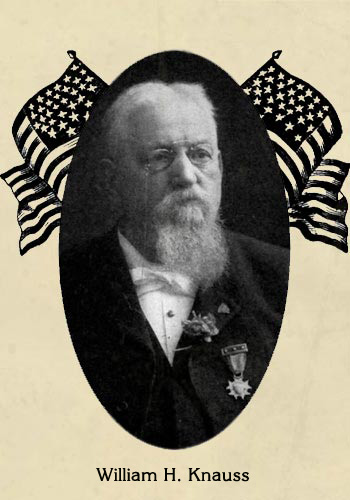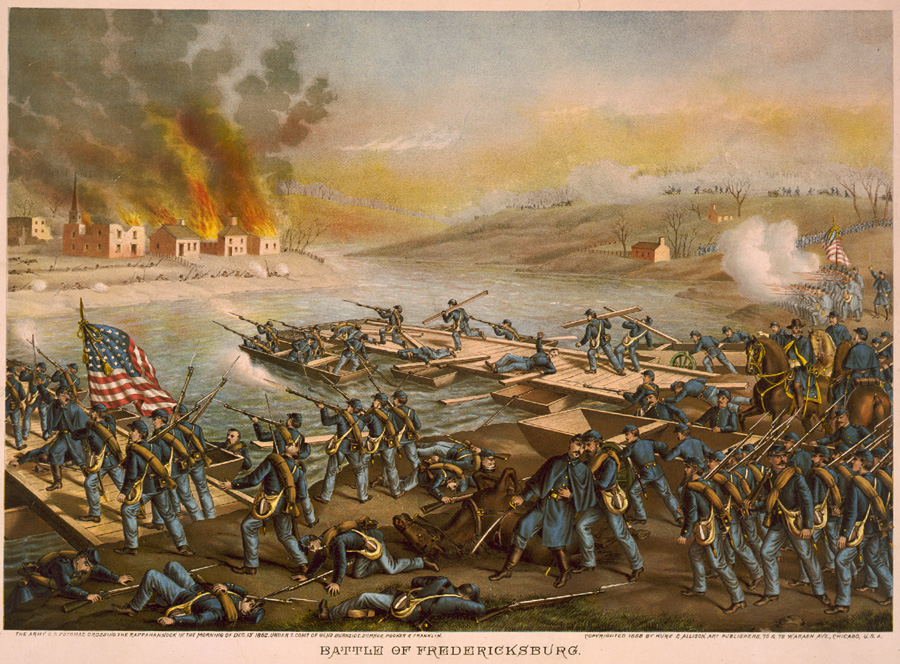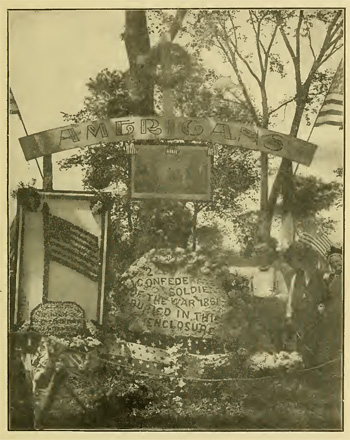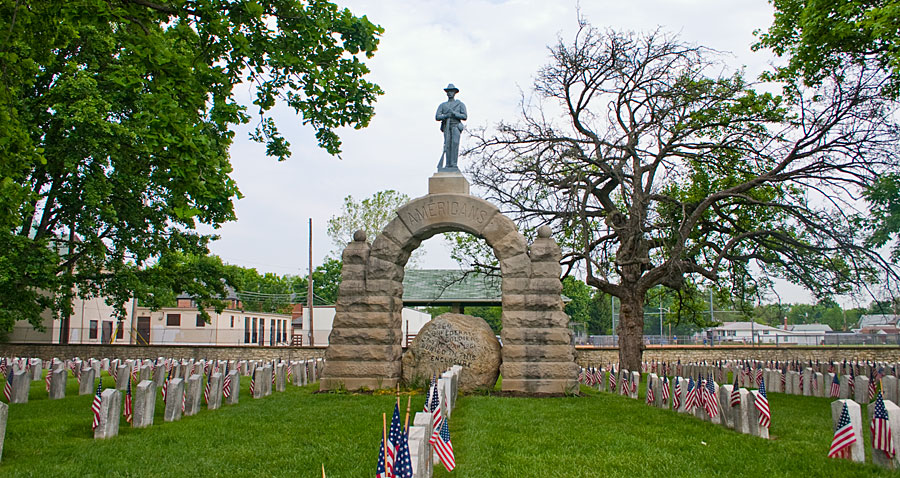
|
SOLD Items Photographs |
||||||||||||||||||||||||||||||||||||||||||||||||||||||||||||||||||||||||||||||||||||||||||||||||||||||||||||||||












|
||||||||||||||||||||||||||||||||||||||||||||||||||||||||||||||||||||||||||||||||||||||||||||||||||||||||||||||||
|
SOLD! SOLD! SOLD! Offered is a wonderful collection of items from the 1906 monument dedication of the 127th Pennsylvania Infantry at Fredericksburg, Virginia. The collection included the monument dedication badge, a photo of the members of the 127th Pennsylvania veterans around the monument wearing the badge, a lone photo of the monument, and a purple ribbon from Sergt. S. G. Sheaffer. The badge hanger has a silver colored metal with a celluloid strip in the middle with "127th PA. VOLS." written on it. Three ribbons are attached to the hanger. The back ribbon is a red, white, and blue ribbon. Written on the ribbon in silver colored ink is "DEDICATION FREDERICKSBURG VIRGINIA JUNE 26, 1906". The second ribbon is a blue color and is a shorter ribbon. The top ribbon is a red, white, and blue ribbon with a large celluloid drop attached. On the celluloid drop is the likeness of the 127th Pennsylvania monument at Fredericksburg, Virginia. The badge was made by the Whitehead & Hoag Company of Newark, New Jersey. There are two photographs. The first photograph is of members of the 127th Pennsylvania Infantry veterans surrounding the monument. Each veteran is wearing the monument dedication badge. This photograph is 12 inches wide and 10 inches tall border to border. The actual photograph is 9 1/8 inches wide and 6 7/8 inches tall. The second photograph is of the 127th Pennsylvania Infantry monument in Fredericksburg by itself. Both photographs were made by L. Mumper, Photographer, 7 Stratton Street, Gettysburg, Pennsylvania as noted by the photographer stamp on the back of each photograph. The monument photograph is 12 inches tall and 10 inches wide. The actual photograph is 7 7/8 inches tall and 6 inches wide. The fourth piece of this collection is a purple ribbon. Written in gold colored ink on the ribbon is "MY FATHER'S G.A.R. -BUTTON- SERGT. S.G. SHEAFFER, CO. I, 127th PENNA. VOL. INFTRY.". The ribbon is approximately 11 inches tall and 3 inches wide. It is very hard to find the badge and the photograph of any monument dedication.
|
||||||||||||||||||||||||||||||||||||||||||||||||||||||||||||||||||||||||||||||||||||||||||||||||||||||||||||||||


|
||||||||||||||||||||||||||||||||||||||||||||||||||||||||||||||||||||||||||||||||||||||||||||||||||||||||||||||||
|
SOLD! SOLD! SOLD! Offered is an image of Charles H. Shaw, Company E, 1st Massachusetts Heavy Artillery. Shaw enlisted in July 1861 as a private. He re-enlisted November 25, 1863. He was listed as a POW at Petersburg, Virginia on June 22, 1864. He was exchanged December 1, 1864 and mustered out on August 8, 1865 in Washington, DC. The image is a bust photograph and is signed in period ink on the back of the carte "Charles H Shaw". The photographer is R.W. Addis, Photographer, 308 Penna. Avenue, Washington, D.C. as noted by the photographers stamp on the back.
|
||||||||||||||||||||||||||||||||||||||||||||||||||||||||||||||||||||||||||||||||||||||||||||||||||||||||||||||||


|
||||||||||||||||||||||||||||||||||||||||||||||||||||||||||||||||||||||||||||||||||||||||||||||||||||||||||||||||
|
SOLD! SOLD! SOLD! Offered is an image of Surgeon William P. Davis of the 10th Iowa Infantry. The image shows Davis in an officers frock coat. Written on the front of the image is "William P. Davis - Surgeon 10th Regt. Iowa Vol. - 1813 - 1867". Written on the back of the CDV is "William P. Davis son of John Davis and his wife, Elizabeth Colehur. Served in the Civil War, was elected state senator in Iowa, 1857. 1813 (?) - 1867 - Surgeon 10th Regt. Iowa Vol. Civil War". 10th Iowa Infantry
|
||||||||||||||||||||||||||||||||||||||||||||||||||||||||||||||||||||||||||||||||||||||||||||||||||||||||||||||||


|
||||||||||||||||||||||||||||||||||||||||||||||||||||||||||||||||||||||||||||||||||||||||||||||||||||||||||||||||
|
SOLD!!! Offered is an image of James W. Beck, Company E, 33rd Indiana Infantry. The image ia a waist up photograph of Beck in his Union uniform. Written in period ink on the back of the imge is "Jas. W. Beck - Co. E, 33 Ind. Regt". Beck mustered in to the 33rd Indiana Infantry in September 1861 and re-enlisted in January 1864. He mustered out in July 1865 in Louisville, Kentucky. He was promoted to Corporal Regimental History Thirty-third Indiana Infantry. — Cols., John Coburn, James E. Burton; Lieut. -Cols., James M. Henderson, James E. Burton, John P. Niederauer; Majs., William J. Manker, Levin T. Miller, John P. Niederauer, John C. Maze. This regiment was organized at Indianapolis and was mustered in Sept. 16, 1861. It left the state Sept. 28, and at Camp Dick Robinson reported to Gen. Thomas. On Oct. 13 it broke camp for Crab Orchard, thence to Camp Wild Cat, where it engaged and defeated Zollicoffer's forces. It then moved back to Crab Orchard, where it remained until April 11, 1862, then joined Gen. George W. Morgan's forces and was engaged in the movements resulting in the capture of Cumberland gap in June. It then took part in the marches and skirmishes in eastern Tennessee until the gap was evacuated in September. The regiment was in various movements until Danville was reached, camping there until the last of Jan., 1863, and then marching to Louisville, Nashville, Brentwood and Franklin. In March it fought Van Dorn's forces near Columbia, and was engaged at Thompson's station, where about 400 of the regiment were captured and nearly 100 killed and wounded. The prisoners were paroled and about two months later were exchanged and joined the regiment. During this time the balance of the regiment remained at Franklin and was in numerous engagements in that vicinity. About the first of July it moved towards Tullahoma; was in the advance on Shelbyville; was stationed at Manchester, Estill Springs, Cowan, Decherd and Tracy City during September and October, and moved to Christiana in November. The regiment enlisted as a veteran organization in Jan. and Feb., 1864, and returned home on furlough. It joined Sherman's army in the spring and took part in the advance upon and siege of Atlanta, being engaged at Resaca, Cassville, New Hope Church, Golgotha, Kolb's farm, Kennesaw mountain, Marietta and Peachtree creek, and was then before Atlanta until the surrender. It was in the engagement at Turner's ferry in August and drove a brigade out of Atlanta Sept. 2, when the mayor surrendered the city to Col. Coburn. The regiment's loss during this campaign was more than 300 in killed and wounded. It remained in camp until Nov. 15, then accompanied the army to Savannah, was in camp there until Jan. 2, 1865, and then took part in the march through the Carolinas, being engaged at Averasboro, and Bentonville. It was at Goldsboro from March 23 to April 10, and at Raleigh until May 1. It then proceeded to Washington, via Richmond, and moved to Louisville in June. While at Washington a part of the 27th, 70th and 85th regiments were assigned to the 33d, and the whole was mustered out at Louisville July 21, 1865. The original strength of the regiment was 948; gain, by recruits, 1,378; reenlistments, 449; total, 2,775. Loss by death, 267; desertion, 113; unaccounted for, 117.Footnotes:Regimental history taken from "The Union Army" by Federal Publishing Company, 1908 - Volume 3
|
||||||||||||||||||||||||||||||||||||||||||||||||||||||||||||||||||||||||||||||||||||||||||||||||||||||||||||||||



|
||||||||||||||||||||||||||||||||||||||||||||||||||||||||||||||||||||||||||||||||||||||||||||||||||||||||||||||||
|
SOLD!!! Offered is an image of George W. Eyestone as an officer. Eyestone started his Civil War career as a private in the 11th Indiana Infantry in August 1861. He fought with the 11th Indiana Infantry until October, 1863 when he was commissioned 1st Lieutenant of the 46th United States Colored Troop. Eyestone was promoted in September 1864 to Captain. He mustered out January 30. 1866. The image has Eyestone dressed as an officer standing with his sword. The photographer was D.P. Barr, Army Photographer, Palace of Art, Vicksburg, Miss. as noted on the rear of the card. The photo has clipped corners. This image does not have any identification but I owned a similar image in my collection which was ink signed. A copy of my collection image will be included with the Civil War image. The copy image is the third scan on the listing. 11th Regiment Infantry "Wallace's Zouaves" (3 Years) Organized at Indianapolis, Ind., August 31, 1861. Moved to Paducah, Ky., September 6, and duty there until February 5, 1862. Attached to 5th Brigade, 2nd Division, Army of the Tennessee, February, 1862. 1st Brigade, 3rd Division, Army of the Tennessee, to July, 1862. Helena, Ark., District of East Arkansas, Dept. of Missouri, to December, 1862. 2nd Brigade, 2nd Division, District of Eastern Arkansas, Dept. of the Tennessee, to January, 1863. 3rd Brigade, 12th Division, 13th Army Corps, Army of the Tennessee, to February, 1863. 1st Brigade, 12th Division, 13th Army Corps, to July, 1863. 1st Brigade, 3rd Division, 13th Army Corps, Army of the Tennessee, to August, 1863, and Dept. of the Gulf to June, 1864. 2nd Brigade, 2nd Division, 19th Army Corps, to August, 1864. 2nd Brigade, 2nd Division, 19th Army Corps, Army of the Shenandoah, Middle Military Division, to January, 1865. 2nd Separate Brigade, 8th Army Corps, Middle Department, to July, 1865. SERVICE.--Operations against Forts Henry and Heiman, Tenn., February 2-6, 1862. Investment and capture of Fort Donelson, Tenn., February 12-16. Expedition to Clarksville, Tenn., February 19-21. Expedition toward Purdy and operations about Crump's Landing, Tenn., March 9-14. Battle of Shiloh, Tenn., April 6-7. Advance on and siege of Corinth, Miss., April 29-May 30. Occupation of Corinth and pursuit to Booneville May 30-June 3. March to Memphis, Tenn., June 3-20, and duty there until July 24. Ordered to Helena, Ark., July 24, and duty there until April, 1863. Expedition from Helena to Arkansas Post, Ark., November 16-21, 1862. Expedition from Helena to Grenada, Miss., November 27-December 5. Tallahatchie November 30. Mitchell's Cross Roads December 1. Moved to Milliken's Bend, La., April 14. Movement on Bruinsburg and turning Grand Gulf April 25-30. Battle of Port Gibson May 1. 14-Mile Creek May 12-13. Battle of Champion's Hill May 16. Siege of Vicksburg, Miss., May 18-July 4. Assaults on Vicksburg May 19 and 22. Advance on Jackson, Miss., July 4-10. Siege of Jackson July 10-17. Duty at Vicksburg until August 6. Ordered to New Orleans, La., August 6; thence to Brasher City, and duty there until October. Western Louisiana Campaign October 3-November 30. Bayou Cortableau October 21. Carrion Crow Bayou November 3. Regiment Veteranize January 1, 1864. Veterans on furlough March 4 to May 8. Duty in District of LaFourche and Defenses of New Orleans, La., until May. At New Orleans, La., until July 19. Ordered to Washington, D. C., July 19. Sheridan's Shenandoah Valley Campaign August 7-November 28. Battle of Opequan, Winchester, September 19. Fisher's Hill September 22. Woodstock September 23. Mt. Jackson September 23-24. Battle of Cedar Creek October 19. Duty in the Shenandoah Valley until January, 1865. Duty at Fort Marshall, Baltimore, Md., January 7 to July 26, 1865. Mustered out July 26, 1865. Regiment lost during service 1 Officer and 114 Enlisted men killed and mortally wounded and 3 Officers and 170 Enlisted men by disease. Total 288.
|
||||||||||||||||||||||||||||||||||||||||||||||||||||||||||||||||||||||||||||||||||||||||||||||||||||||||||||||||



|
||||||||||||||||||||||||||||||||||||||||||||||||||||||||||||||||||||||||||||||||||||||||||||||||||||||||||||||||
|
SOLD! SOLD! SOLD! Offered is an image of Lt. Jonathan Pickerel. Pickerel started his Civil War career when he mustered in Co. C, 48 Indiana Infantry in January 1862 as Corporal. In June 1863 he was discharged for promotion to the 49th Untied State Colored Troop. He was promoted to 2nd Lieutenant on June 1, 1863. He was promoted to 1st Lieutenant on April 1, 1864. He resigned December 22, 1864. The image has a bust shot of Pickerel as an officer. The back mark is Washington Gallery, Odd Fellow's hall, Vicksburg, Miss. as noted on the rear of the CDV. The image is not marked in anyway but included is another copy image of Pickerel wearing a tam hat which is signed. This printed copy comes with the CDV.
|
||||||||||||||||||||||||||||||||||||||||||||||||||||||||||||||||||||||||||||||||||||||||||||||||||||||||||||||||



|
||||||||||||||||||||||||||||||||||||||||||||||||||||||||||||||||||||||||||||||||||||||||||||||||||||||||||||||||
|
SOLD!!! SOLD!!! SOLD!!! Offered is a Civil War image of General Rufus Ingalls. The actual image is a CDV size of 2 5/16 inches wide and 3 1/4 inches wide. The backing the photo is attached to is 5 1/2 inches wide and 7 inches tall. General Ingalls was probably the only officer in the Army of the Potomac who provided every commander of that corp great satisfaction. Ingalls graduated from West Point and served in the Mexican war where he served with his friend and intimate U.S. Grant. He had an interesting career in the prewar army. Early in the war Ingalls was appointed chief quartermaster of the Army of the Potomac and he retained that position for all of the war. Not an easy task with many of the generals coming and going. Ingalls served for 40 years and died in 1893.
|
||||||||||||||||||||||||||||||||||||||||||||||||||||||||||||||||||||||||||||||||||||||||||||||||||||||||||||||||






|
||||||||||||||||||||||||||||||||||||||||||||||||||||||||||||||||||||||||||||||||||||||||||||||||||||||||||||||||
|
SOLD! SOLD! SOLD! Offered is a great photograph of
Confederate veterans in Bosque County, Texas.
There are fourteen Confederate veterans sitting in front of a
store. A couple of veterans are wearing
Southern Crosses of Honor. There are at
least two veterans wearing 1902 Dallas, Texas UCV national badges. Several other ribbons and badges are worn by the
other Confederate veterans. The photograph
is mounted on a hard board. The board is
approximately 10 15/16 inches long and 8 ½ inches tall. The photograph is 9 ½ inches long and 7 ¾
inches tall. I found a copy of this photograph
in the Liljenquist Family Collection in the Library of Congress. The photograph had all the veterans
identified. I have made a copy of this
and included it with the photograph.
|
||||||||||||||||||||||||||||||||||||||||||||||||||||||||||||||||||||||||||||||||||||||||||||||||||||||||||||||||




|
||||||||||||||||||||||||||||||||||||||||||||||||||||||||||||||||||||||||||||||||||||||||||||||||||||||||||||||||
|
SOLD!!! Offered is a photograph of a
monument dedication held in Hollywood Cemetery in Richmond, Virginia. There are at least three Confederate veterans
in the photograph. Also in the
photograph are at least one Grand Army of the Republic member and several other
men dressed in military uniforms. A
wreath lies next to the monument.
Written on the monument is “Memorial to the Confederate Women of
Virginia 1861 – 1865 - The legislature of Virginia of 1914, Has at
the solicitation of Ladies Hollywood Memorial Association and United Daughters
of Confederacy of Virginia, Placed in perpetual care this section where lie
buried Eighteen thousand Confederate soldiers.” The monument is located at the Confederate pyramid monument in the cemetery. The photograph is mounted on a
gray card. The card is approximately 7
1/8 inches long by 5 inches tall. The
photograph is approximately 5 5/8 inches long by 3 11/16 inches tall.
|
||||||||||||||||||||||||||||||||||||||||||||||||||||||||||||||||||||||||||||||||||||||||||||||||||||||||||||||||



|
||||||||||||||||||||||||||||||||||||||||||||||||||||||||||||||||||||||||||||||||||||||||||||||||||||||||||||||||
|
SOLD!!! A nice photograph of nine Confederate veterans seated in front of the State Bank in West Point, Virginia. There are four veterans standing and five veterans sitting. I counted at least four Southern Crosses and there are other badges on these veterans. The Confederate veterans are identified on the back of the photograph. Written in pencil on the back of the photograph is “Top row – Left to Right – Churchhill Cook, Mayo, Reed, King - (Bottom Row) McGeorge, Edmund, Martin, Fogg, Dr. Munn”. Also written in ink on the back of the photograph is “Last of the old Vets ___?___?! taken in West Point in front of State Bank”. The photograph is approximately 5 9/16 inches wide and 3 ¾ inches tall. There are some bends in the photograph. Please look at the photographs.
|
||||||||||||||||||||||||||||||||||||||||||||||||||||||||||||||||||||||||||||||||||||||||||||||||||||||||||||||||




|
||||||||||||||||||||||||||||||||||||||||||||||||||||||||||||||||||||||||||||||||||||||||||||||||||||||||||||||||
|
SOLD! SOLD! SOLD! Offered is a nice photograph of T. Julias Worsham and W. J. Horsley. Both are members of the Georgia Division of the United Confederate Veterans. Both Confederate veterans are standing in the photograph. The man on the left side is T. Julias Worsham. He is wearing a dark suit and a United Confederate Veterans badge on his lapel. The man standing next to him is W. J. Horsley. Horsley is wearing his United Confederate Veterans double brested frock coat. On the collar of the coat are two stars which denote his rank in his local camp. Written under the photograph in period ink is "T.J. Worsham/W.J. Horsley". In 1915 Horsley was the Commander of the Southern Division of the Georgia Department of the United Confederate Veterans. Worsham served in the 1st Battalion Georgia Reserve Cavalry. The actual photograph is approximately 5 7/8 inches by 4 1/8 inches . The card has been trimmed down and is approximately 6 1/2 inches by 4 1/2 inches.
|
||||||||||||||||||||||||||||||||||||||||||||||||||||||||||||||||||||||||||||||||||||||||||||||||||||||||||||||||





|
||||||||||||||||||||||||||||||||||||||||||||||||||||||||||||||||||||||||||||||||||||||||||||||||||||||||||||||||
|
SOLD!!!
Offered is a nice photograph of Peter B. Epes of the 3rd Virginia Cavalry. Epes enlisted on February 2, 1863 and was paroled on April 16, 1865. He was wounded twice. The first time at Mitchell's Shop, Virginia on May 9, 1864 and the second wound was taken on January 15, 1865 at a place not specified. The photo has Epes standing in his United Confederate Veterans uniorm. He is wearin three UCV badges. One appears to be the Gettysburg Virginia monument badge! The photo is approximately 6 inches by 4 inches. Epes or Eppes as his decindents spelled his name, is in a full standing pose.
|
||||||||||||||||||||||||||||||||||||||||||||||||||||||||||||||||||||||||||||||||||||||||||||||||||||||||||||||||


|
||||||||||||||||||||||||||||||||||||||||||||||||||||||||||||||||||||||||||||||||||||||||||||||||||||||||||||||||
|
SOLD!!! SOLD!!! SOLD!!! Offered is a nice image of General U.S. Grant. Grant is standing and is wearing a mourning ribbon for President Abraham Lincoln. Written under the image is “Lieut. Gen. U. S. Grant”. There is no back mark.
|
||||||||||||||||||||||||||||||||||||||||||||||||||||||||||||||||||||||||||||||||||||||||||||||||||||||||||||||||


|
||||||||||||||||||||||||||||||||||||||||||||||||||||||||||||||||||||||||||||||||||||||||||||||||||||||||||||||||
|
SOLD! SOLD! SOLD! Offered is a CDV of General William Woods Averell. Averell graduated West Point in 1851 and had two years rugged service against the southwestern Indians, during which he was severly wounded. He invalided out until the outbreak of the Civil War. He took part in the first battle of Manassass and was then commisioned Colonel of the 3rd Pennsylvania Cavalry. He participated in the Peninsular campaign as commander of a brigade; in the campaign which culminated at Sharpsburg; at Fredericksburg, in December, 1862; and in various skirmishes of the mounted branch of the Army of the Potomac. His 2nd Cavalry Division won the first claimed victory of the Federal horse over the COnfederates at Kelly's Ford, Virginia, in March, 1863 - an action said to have been the turning point of cavalry fighting in the Eastern theater. Meanwhile he was appointed brigadier general of volunteers on September 26, 1862. After taking part in George Stoneman's famous but ill-starred raid on Richmond during the campaign of Chancellorsville, Averell was employed in monor operations in western Virginia until Philip Sheridan's Shenandoah campaign. At the end of the war he was brevetted brigadier and Major general, U.S. Army, and resigned on May 18, 1865. The image is a bust shot of Averell in a brigadiers uniform. The backmark is "Photographed by Ewing & Co., Cumberland, MD.". The upper right back corner is missing a small amount of the backing card. This does not affect the image.
|
||||||||||||||||||||||||||||||||||||||||||||||||||||||||||||||||||||||||||||||||||||||||||||||||||||||||||||||||









|
||||||||||||||||||||||||||||||||||||||||||||||||||||||||||||||||||||||||||||||||||||||||||||||||||||||||||||||||
|
SOLD!!!
Offered is an outstanding photograph of the Confederate monument dedication at Camp Chase, Ohio POW cemetery. This hard to find photograph has the monument with a banner saying "AMERICANS" over it with American flags. Rifles are stacked in the front of the photograph. What looks like Ohio National guard are on either side of the monument. W.H. Knauss and W.B. Albright are shaking hand to the right of the monument. On an attached slip of paper on the back of the photograph, it says "W.H. Knauss the Union soldier, presenting a bouquet of flowers - as God's token of love for mankind - to W.B. Albright the Confederate soldier. Guns stacked, war over, let all enmity and prejudice cease and let peace prevail all over the land of the brave. Stamped on the back of the photograph is "Duplicates of this Photo 25 cents, each prepaid. C.L. Johnston. 74 1/2 N. High St., Columbus, Ohio.". The photographer Johnson and W.H. Knauss signed the photograph in the right bottom corner. At the monument dedication the zinc Confederate soldier was not attached. This is the part of the statue that has recently been defaced. The actual photograph is approximately 8 inches by 6 1/8 inches. The board portion of the photograph is approximately 10 1/8 inches by 7 1/8 inches. There is a thin wooden support to the top of the photograph.
|
||||||||||||||||||||||||||||||||||||||||||||||||||||||||||||||||||||||||||||||||||||||||||||||||||||||||||||||||
| Additional Pages |
| 1 2 3 4 5 6 7 8 9 10 11 12 13 14 15 16 17 18 19 20 21 22 23 24 25 26 27 28 29 30 31 32 33 34 35 36 37 38 39 40 41 [Next Page] |
|---|
Cash, Check, Money Order, and PayPal
 We now accept PAYPAL for those of you who would like to use credit cards! Please send to vann@veteransattic.com . Your satisfaction and happiness is our major concern. We will be glad to refund your purchase price if you are not happy with your purchase if returned within fifteen days of your receipt.
You can order through our web site or you can call 803-431-1798 for your order. Sales are complete when we confirm items are still in stock.
We ship using the United States Post Office.
|




 Antietam
Antietam